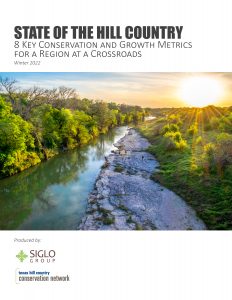State of the Hill Country Report Now Available
 The Hill Country is growing. Population is booming and communities are trying to keep up with soaring demand. The State of the Hill Country Report helps give a snapshot of conditions and policies that effect land, water, and communities in our area.
The Hill Country is growing. Population is booming and communities are trying to keep up with soaring demand. The State of the Hill Country Report helps give a snapshot of conditions and policies that effect land, water, and communities in our area.
Informed decisions are a more sustainable way to manage the delicate resources of the Hill Country. We hope this in-depth report provides the details and analyses needed to inform policies and development decisions.
We’re proud to have collaborated with other partners in the Texas Hill Country Conservation Network to make this metrics report possible.
For Immediate Release February 28, 2022
State of the Hill Country Report Reveals Threats to the Region
DRIPPING SPRINGS, Texas — Booming population growth and sprawling development, groundwater depletion, changing climate patterns, extreme droughts and floods, and a unique set of policy challenges threaten the natural resources that define the Hill County region—resources on which millions of people rely.
A recently released report from the Texas Hill Country Conservation Network (THCCN) sets a baseline for eight key metrics to examine the current state of conservation and growth in the Hill Country. What it reveals is a region at a crossroads, facing tremendous threats to its future.
“This report makes it perfectly clear—the Hill Country’s breathtaking vistas, natural spaces, clear waters, abundant wildlife, starry night skies, and small-town charms must not be taken for granted,” warns Katherine Romans, Hill Country Alliance Executive Director and Chair for the THCCN. “The choices we collectively make now will determine whether the region and its inhabitants survive and thrive, or whether we willfully live beyond the means and carrying capacity of this place we call home.”
The eight metrics used for the State of the Hill Country Report are:
- Population growth in unincorporated areas. Rapid increases in populations outside of existing municipal areas, coupled with a lack of county land use tools, have resulted in land fragmentation, loss of ecological connectivity and function, and incompatible land uses—ultimately bringing negative impacts on water quality and quantity, biodiversity, and night sky visibility.
- Conserved lands. Conserved natural areas, working farms and ranches, and public lands cleanse and store the Hill Country’s water supply and provide wildlife habitat while preserving space for residents and visitors. Less than 5% of the Hill Country has been conserved to date.
- Developed lands. Developed lands are characterized by impervious cover, which increases runoff, decreases infiltration, increases contamination, and drives flash flooding. To maintain functioning ecosystems, we need to conserve land as fast as we develop it. Currently, an average of 7% of the Hill Country is developed, with much higher percentages in some counties.
- Pristine streams. The Hill Country is home to the most pristine waterways of any region in the state, but they are increasingly under threat from the discharge of treated wastewater from the region’s growing population. These pristine streams support the region’s vibrant tourism and recreation-based economies and contribute known value to the lands that surround them, both public and private
- Per capita water consumption. A growing population is placing increased demands on our limited water supply with some areas using an unsustainable amount of water. A better understanding of demand and consumption trends will help inform strategies to maintain clean water supply for wildlife, plants, agricultural lands, and all Hill Country residents.
- Spring flow. Springs provide critical baseflow for Hill Country streams and are necessary to sustain the unique flora and fauna of the Hill Country, recreational activities like fishing and swimming, and drinking water upon which millions of Texans rely. An increase in water demand and a changing climate is placing pressure on this finite but critical resource.
- Night sky visibility. Naturally dark skies are vital for the region’s quality of life, local tourism economies, and wildlife but are at risk due to increased development. Night sky friendly outdoor lighting benefits residents, wildlife and tourism.
- Conservation investment. The region has seen tremendous support for public funding of land conservation, but it is not keeping pace with our region’s rise in gross domestic product (GDP). Hill Country organizations can use this data to advocate for conservation funding that increases proportionally to economic growth.
The State of the Hill Country Report is a product of the Texas Hill Country Conservation Network, a partnership of dozens of organizations working across the 18-county region of Central Texas to expand protection of natural resources through collaborative conservation and promoting better ways to accommodate growth.
“This report is a call to action for sustained collaborative efforts to secure the valuable assets delivered by Hill Country land, water and skies,” said Jennifer Walker, National Wildlife Federation’s Deputy Director for the Texas Coast and Water Program and Vice Chair of the THCCN. “The window of opportunity to protect and sustain the Hill Country’s natural treasures will likely close within our generation. Understanding how to balance development and conservation in service of these goals is key to that sustainability.”
For a full copy of the State of the Hill Country Report and to learn more about the Texas Hill Country Conservation Network go to: OurTxHillCountry.org.